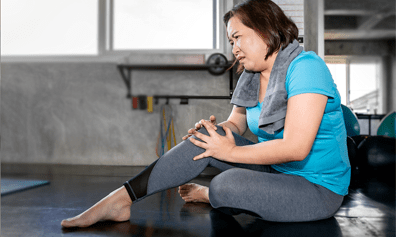
How and why do pelvic floor problems occur?
- • Pelvic floor problems can occur when the pelvic floor muscles are stretched, weakened, or too tight
- • Some people have weak pelvic floor muscles from an early age, while others notice problems after certain life stages such as pregnancy, childbirth, or menopause
- • Some people have pelvic floor muscles that are too tight and cannot relax.
- • Pelvic floor muscle tightness can be made worse by doing squeezing exercises and overworking the muscles without learning how to relax.
Signs of a pelvic floor problem
Common signs that can indicate a pelvic floor problem include:
- • accidentally leaking urine when you exercise, laugh, cough, or sneeze
- • needing to get to the toilet in a hurry or not making it there in time
- • constantly needing to go to the toilet
- • finding it difficult to empty your bladder or bowel
- • accidentally losing control of your bladder or bowel
- • accidentally passing wind
- • a prolapse
- • in women, this may be felt as a bulge in the vagina or a feeling of heaviness, discomfort, pulling, dragging or dropping
- • in men, this may be felt as a bulge in the rectum or a feeling of needing to use their bowels but not actually needing to go
- • pain in your pelvic area
- • painful sex
Factors affecting pelvic floor muscles
Pelvic floor muscle fitness is affected by several things, including
- • not keeping them active or overworking them
- • being pregnant and having babies
- • a history of back pain
- • ongoing constipation and straining to empty the bowels
- • being overweight or obese
- • heavy lifting (e.g. at work or the gym)
- • a chronic cough or sneeze (e.g. due to asthma, smoking or hayfever)
- • previous injury to the pelvic region (e.g. a fall, surgery or pelvic radiotherapy)
- • aging
Strengthening your pelvic floor muscles will help you to actively support your bladder and bowel. Your pelvic floor muscles can be strengthened with a regular exercise program. This is important for both men and women.
Pelvic floor muscles strengthening exercises
1. Kegels
- • Pelvic muscle training, or Kegels, is the practice of contracting and relaxing your pelvic floor muscles.
- • You may benefit from Kegels if you experience urine leakage from sneezing, laughing, jumping, or coughing, or have a strong urge to urinate just before losing a large amount of urine.
- 1 Identify the right muscles. The easiest way to do this is to stop urination midstream. These are your pelvic floor muscles.
- 2 To perform Kegels, contract these muscles and hold for 5 seconds. Release for 5 seconds..
- 3.Repeat this 10 times, 3 times a day.
2. Squats
Squats engage the largest muscles in the body and have one of the largest payoffs in terms of strength improvement. When performing this fundamental move, ensure your form is solid before you add any resistance.
- 1.Stand in an upright position, feet slightly wider than shoulder-width apart and toes slightly pointed out. If using a barbell, it should be rested behind your neck on your trapezius muscles..
- 2.Bend your knees and push your hips and butt back as if you’re going to sit in a chair. Keep your chin tucked and neck neutral.
- 3.Dropdown until your thighs are parallel to the ground, keeping your weight on your heels and knees bowed slightly outward.
- 4.Straighten your legs and return to an upright position.
- 5.Complete 15 reps.
3.Bridge
The bridge is an excellent exercise for the butt muscles. If done correctly, it also activates the pelvic floor muscles in the process.
- 1.Lie on the floor. Your spine should be against the ground, with knees bent at a 90-degree angle, feet flat, and arms straight at your sides with palms facing down..
- 2.Inhale and push through your heels, raising your hips off the ground by squeezing your butt muscles, thigh muscles, and pelvic floor. Your body — resting on your upper back and shoulders — should form a straight line down from the knees.
- 3.Pause 1–2 seconds in the raised position before returning to the starting position.
- 4.Complete 10–15 reps and 2–3 sets, resting 30–60 seconds between sets.
Take it to the next level
- • For an added challenge, complete this exercise on a stability ball.
- • In the starting position, place your feet on the ball with your back flat on the ground and repeat the steps above
4.Split tabletop
Tabletop is a leg move that acts as the foundation of many activities in a Pilates workout. By adding the split, you’re activating your hips and pelvic floor muscles as well. Start with your back on the floor and knees bent so your thighs are perpendicular to the floor, and your shins are parallel to the floor.
- 1. Your abs should be braced and your inner thighs should be activated, legs touching.
- 2. In a controlled movement, begin to slowly split your legs so each knee falls outward, reaching a comfortable position.
- 3. Slowly raise back to the start..
- 4. Complete 10–15 reps and 3 sets.
5.Bird dog
An exercise in balance and stability, a bird dog is a full-body move that makes you engage many muscles at once, including the pelvic floor.
- 1. Start on all fours with wrists under shoulders and knees under hips. Your back should be straight, and your neck should be neutral.
- 2. Brace your core and draw your shoulder blades down your back toward your hips..
- 3. To start the move, simultaneously straighten and raise your left leg and right arm, keeping your pelvis and shoulders in a neutral position. Don’t raise or lower your head. Hold for 2 seconds.
- 4. Bend and lower your leg and arm down back to the starting position while maintaining stability. Then switch, raising your right leg and left arm. This is one rep.
- 5. Complete 10 total reps and 3 sets.
Telehealth to Your Rescue
During these times of global pandemic, it can be challenging to find the help you need to maintain your joint health. But with telerehabilitation services, you can get the benefits of physical therapy from the comfort of your home without worrying about exposure or transport. .
TheraNow, one of the best telerehabilitation services with excellent expertise in the field of online physical therapy, with our team of virtual physical therapists who are waiting to provide you the care you need to get your life back in its happy place. You can book your appointment by visiting us at Theranow: Online Physical Therapy Services
































































